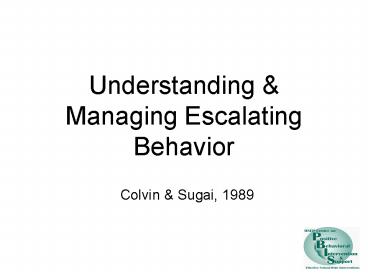Understanding - PowerPoint PPT Presentation
1 / 20
Title:
Understanding
Description:
Understanding & Managing Escalating Behavior. Colvin & Sugai, 1989. The Escalation ... Student experiences a series of ... Disengage from student. 5. Peak ... – PowerPoint PPT presentation
Number of Views:29
Avg rating:3.0/5.0
Title: Understanding
1
Understanding Managing Escalating Behavior
- Colvin Sugai, 1989
2
The Escalation Cycle
High
Peak
Acceleration
De-escalation
Agitation
Trigger
Calm
Recovery
Low
3
Effects of Escalating Phases
- Peak
- Student is out of control displays most severe
problem behavior. - De-escalation
- Student displays confusion but with decreases in
severe behavior. - Recovery
- Student displays eagerness to participate in
non-engagement activities.
- Calm
- Student is cooperative.
- Trigger
- Student experiences a series of unresolved
conflicts. - Agitation
- Student exhibits increase in unfocused behavior.
- Acceleration
- Student displays focused behavior.
4
PURPOSE
- Enhance our understanding of ways of responding
to escalating behavior sequences.
5
ASSUMPTIONS
- Behavior is learned.
- Behavior is escalated through successive
interactions (practice). - Behavior can be changed through an instructional
approach.
6
OUTCOMES
- Identification of how to intervene early in an
escalation. - Identification of environmental factors that can
be manipulated. - Identification of replacement behaviors that can
be taught.
7
1. Calm
- Student is cooperative.
- Accepts corrective feedback.
- Follows directives.
- Sets goals for learning.
- Ignores distractions.
- Accepts encouragement reinforcement.
8
Calm
- Intervention is focused on prevention.
- Arrange for high rates of successful academic
social engagements. - Use positive encouragement and reinforcement.
- Teach social skills.
- Problem solving
- Relaxation strategy
- Self-management
- Communicate positive expectations.
9
2. Trigger
- Student experiences a series of unresolved
conflicts. - Repeated failures
- Frequent corrections
- Interpersonal conflicts
- Timelines
- Low rates of positive encouragement
10
Trigger
- Intervention is focused on prevention
redirection. - Remove from or modify problem context.
- Increase opportunities for success.
- Reinforce and encourage what has been taught.
11
3. Agitation
- Student exhibits increase in unfocused behavior.
- Off-task
- Frequent start/stop on tasks
- Out of seat
- Talking with others
- Social withdrawal
12
Agitation
- Intervention is focused on reducing anxiety.
- Make structural/environmental modifications.
- Provide reasonable options choices.
- Involve in successful engagements.
13
4. Acceleration
- Student displays focused behavior.
- Provocative
- High intensity
- Threatening
- Personal
14
Acceleration
- Intervention is focused on safety.
- Remember
- Escalations self-control are inversely related.
- Escalation is likely to run its course.
15
Acceleration
- Remove all triggering competing maintaining
factors. - Follow crisis prevention procedures.
- Establish follow through with bottom line.
- Disengage from student.
16
5. Peak
- Student is out of control displays most severe
problem behavior. - Physical aggression
- Property destruction
- Self-injury
- Escape/social withdrawal
- Hyperventilation
17
Peak
- Intervention is focused on safety.
- Procedures like acceleration phase, except focus
is on crisis intervention
18
6. De-escalation
- Student displays confusion but with decreases in
severe behavior. - Social withdrawal
- Denial
- Blaming others
- Minimization of problem
19
De-escalation
- Intervention is focused on removing excess
attention. - Dont nag.
- Avoid blaming.
- Dont force apology.
- Emphasize starting anew.
20
7. Recovery
- Student displays eagerness to participate in
non-engagement activities. - Attempts to correct problem.
- Unwillingness to participate in group activities.
- Social withdrawal sleep.
21
Recovery
- Intervention is focused on re-establishing
routines activities. - Follow through with consequences for problem
behavior. - Positively reinforce and encourage any displays
of appropriate behavior.
22
Recovery
- Debrief
- Purpose of debrief is to facilitate transition
back to program. - Debrief follows consequences for problem
behavior. - Goal is to increase more appropriate behavior.
23
Recovery
- Problem solving example
- What happened ? (define the problem)
- What choice did you make? (define responsibility)
- What needs to happen now? (define repairing)
- What support do you need? (create solutions)
- What can you do next? (make a plan)
- Are you able to do it? (support)
- If not, what would help look like? (support)
24
THREE KEY STRATEGIES
- Identify how to intervene early in an escalation.
- Identify environmental factors that can be
manipulated. - Identify replacement behaviors that can be taught.































